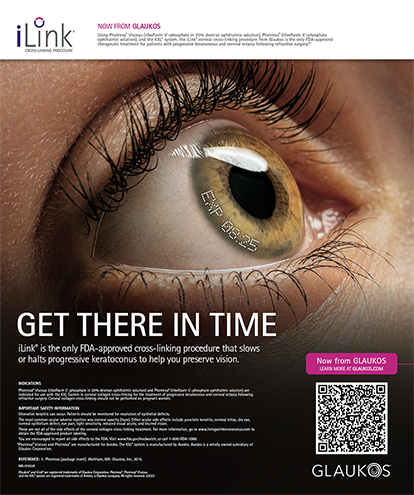Recent surgical advances in cataract surgery bring us closer to ophthalmology's ultimate goal, which is to achieve the best possible uncorrected distance and near vision. For-tunately, surgeons have new technologies that will allow us to reach this goal. These technologies include multifocal IOLs, toric IOLs, the use of relaxing corneal incisions to correct pre-existing astigmatism, and the increasing use of LASIK associated with cataract surgery in order to correct residual amounts of anisometropia and astigmatism.
What do all these technologies have in common? To a greater or lesser degree, they all increase a patient's amount of spherical aberration or decrease his contrast sensitivity so that it is more difficult for him to see 20/20 through a multifocal than a single-vision lens. Therefore, in addition to the responsibility of performing great surgery, cataract surgeons must also preserve macular function. We achieve that goal by two methods: (1) minimizing the production of intraocular prostaglandins and (2) controlling the amount of postoperative inflammation. I believe that the recovery of visual acuity after cataract surgery directly relates to the amount and duration of postoperative inflammation. Therefore, any steps surgeons can take to decrease either the amount of inflammation that occurs initially in the procedure or the duration that it lasts will positively impact patients' outcomes.
NOT A REPLACEMENT FOR STEROIDS
Nonsteroidal anti-inflammatory drugs (NSAIDs) were first introduced in 1991. The initial indications for their use were to maintain pupil dilation during cataract surgery, potentiate the mydriasis, or inhibit the intraoperative miosis. Later, studies such as the one I conducted1 showed that, for routine amounts of postoperative inflammation, NSAIDs could be as effective as steroids at controlling postoperative inflammation. At that time, I was least interested in the fact that NSAIDs were such powerful inhibitors of cyclooxygenase. In retrospect, many of those studies actually did our profession a disservice because they gave the impression that NSAIDs could be used in place of steroids. Over the past 12 years, I have learned how much steroids and NSAIDs differ from one another. Today, my primary use of NSAIDs in cataract surgery is in the prophylaxis and treatment of cystoid macular edema. My secondary use is for their efficacy at reducing the pain associated with clear corneal cataract surgery. These indications now overshadow the use of NSAIDs to maintain a widely dilated pupil and control postoperative inflammation. At the ASCRS meeting this year, I am presenting a study2 in which my colleagues and I randomized 300 patients to receive NSAID drops either on the day of surgery or q.i.d. for 3 days prior to surgery. We then asked patients to rate the level of discomfort of their clear corneal cataract surgery. The patients with 3 preoperative days of NSAID use described a statistically significant lessened awareness of discomfort than those who only received NSAID drops on the day of surgery.
WHY INFLAMMATION OCCURS AFTER CATARACT SURGERY
Inflammation after cataract surgery begins with tissue injury. This damage causes the activation of phospholypase A-2, which breaks down cell membranes into arachidonic acid. The acid either is converted to prostaglandins by cyclooxygenase, or converted to hydroxy acids and leukotrienes by 5-lipoxygenase. Steroids and NSAIDs affect this reaction very differently: steroids act on phospholypase A-2 to stop the breakdown of cell membranes to arachidonic acid, while NSAIDs act on cyclooxygenase to inhibit the conversion of arachidonic acid to prostaglandins. Nonsteroidals are more effective blockers of prosta-glandin production than are corticosteroids.
QUESTIONING TRADITION
Because NSAIDs are such effective agents in block-ing the production of prostaglandins, in 1996, I had to ask the question, “Why have cataract surgeons traditionally waited until after surgery to initiate therapy?” Couldn't we initiate therapy before surgery to block the action of cyclooxygenase so that, when this inflammatory cascade occurs, prostaglandins would not be produced? Subsequently, my colleagues and I published a study in 19963 that randomized our cataract surgery patients into three groups. The first group began taking NSAIDs q.i.d. 3 days prior to surgery, and also received the drugs along with their dilating drops on the day of surgery. The second group only received NSAIDs on the day of surgery, and the third group received no preoperative NSAIDs. We found that the patients who had taken NSAIDs 3 days preoperatively had a statistically significant decrease in their amount of inflammation on the first postoperative day, compared with the patients in the other two groups.
CONCLUSION
Using topical ophthalmic NSAIDs for 3 days prior to surgery decreases the amount of patients' postoperative inflammation. I also continue to use steroids postoperatively to reduce the duration of inflammation. In combination, these two agents give my patients the best likelihood of a great outcome without the risk of developing cystoid macular edema.
1. Roberts CW, Brennan KM. A comparison of topical diclofenac with prednisolone for post cataract inflammation. Archives Ophthalmology. 1995;113:725-727.
2. Roberts CW. Pretreatment with topical NSAIDS to decrease pain during cataract surgery. To be presented at: the ASCRS meeting; April 14, 2003; San Francisco, CA.
3. Roberts CW. Pretreatment with topical diclofenac sodium to decrease postoperative inflammation. Ophthalmology. 1996;103:4:636-639.


